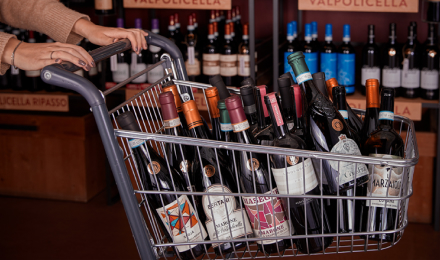THE HISTORY OF DOLCETTO
Although its name suggests a sweet wine, the name of Dolcetto may derive from the Piedmontese dialect “dusset” (hump), referring to the gentle hills on which the grapes thrive. Other theories associate the etymology with the high sugar content of Dolcetto grapes when ripe, and, for this reason, they were sold as a table variety. Whatever the origin of the name, Dolcetto is definitely not a sweet wine. In fact, despite being fruity and soft, this is a particularly dry wine. The Dolcetto variety has a very long history, and it is difficult to establish its origins with certainty. The variety is considered to be native to Piedmont, selected in the late Middle Ages in and around Cuneo. However, this is not the only theory put forward. The origins of Dolcetto may date back even further, and may be found in the neighbouring region of Liguria di Ponente. Dolcetto would have arrived in Piedmont – and, in particular, in the Langhe, via one of the many salt roads connecting the areas inland with the coast for the provision of essential supplies. The earliest document, a deed from the municipality of Dogliani, which mentions this typical Piedmont wine dates back to 1593, when Dolcetto was widespread in the areas of Acqui and Alessandria. Over the years, cultivation of Dolcetto has been consolidated, and the variety has seen significant expansion, probably thanks to its robust character, which means it can adapt to various climates and soils. An interesting fact about Dolcetto is that, in the early 20th century, it was used for grape therapy (ampelotherapy) due to its delicacy, being low in acidity and rich in tannins. Dolcetto’s first DOC designation was awarded in 1972, with the title Dolcetto di Ovada. Other DOC designations have followed over the years, thanks to improved quality of Dolcetto production. Three wines made from Dolcetto grapes – Dogliani DOCG, Dolcetto di Diano d’Alba DOCG and Dolcetto di Ovada Superiore DOCG – have finally obtained DOCG designation.
CHARACTERISTICS OF DOLCETTO
Like other red wines from Piedmont, including Barbera, Dolcetto is a light, medium-bodied wine. Vinified as a monovarietal, Dolcetto generally has a dark ruby red colour, leaning towards purple, and on the nose, it is vinous, but also fresh and floral, with notes of liquorice, blackberry and cherry. This is a medium-bodied, fresh and tannic wine, with moderate alcohol content (at least 11.5%). Unlike wines made from grapes of the Nebbiolo variety – including the fine wines Barolo and Barbaresco from Piedmont –, wines made from Dolcetto grapes are very drinkable, and are best enjoyed young. To guarantee the freshness of Dolcetto’s fruity and floral notes, this wine is generally vinified in inert containers – especially stainless steel tanks –, and rarely in barrels or barriques. There are exceptions, such as Dolcetto di Ovada Superiore DOCG, which demonstrates how this wine can age elegantly, thanks to the large presence of tannins. These are, however, exceptions. Unlike Nebbiolo for example, Dolcetto does not have the acidity necessary to be deemed a wine suitable for ageing and maturation.
DOLCETTO D’ALBA, D’ASTI AND OTHER VARIETIES
Depending on the production area, there are different types of Dolcetto with different characteristics. The most well known of all is probably Dolcetto d’Alba. Its main characteristics are an intense ruby red colour, which may be purplish in its delicate foam, and a dry, bitter flavour with moderate acidity. Another very widespread variety of Dolcetto is Dolcetto d’Asti. This is a ruby red wine, which is harmonious, dry, and velvety on the palate. While Dolcetto di Diano d’Alba has a very dry flavour with clear notes of almond. In its Superiore version, Dolcetto has an ageing requirement of one year and an ABV of at least 12.5%, which convey an accentuated feeling of structure and softness compared to the non-aged types of Dolcetto.
PAIRING DOLCETTO
As this is a very versatile wine, vinified in various versions, pairings with Dolcetto are virtually endless. Given its freshness, it is a great wine to offer as an aperitif with friends, perhaps paired with a cheese board, particularly mature cheeses. To continue the dairy theme, Dolcetto goes extremely well with fondue. Dolcetto is the perfect red wine for Sunday lunch, especially if it includes roasts and white meats, but also grilled beef. For those who love oriental food, Dolcetto is also a great partner for chicken curry. Although red wine does not normally ever go with fish dishes, Dolcetto is an exception. In fact, this typical Piedmontese wine is perfect for accompanying one of the most traditional dishes from Piedmont, bagna cauda, with a sauce made of garlic and anchovies. And that is not all. Venturing into the region of Tuscany, you can pair Dolcetto d’Alba with a cacciucco alla livornese, a soup made from various types of fish, and enriched with tomato and toasted bread.







